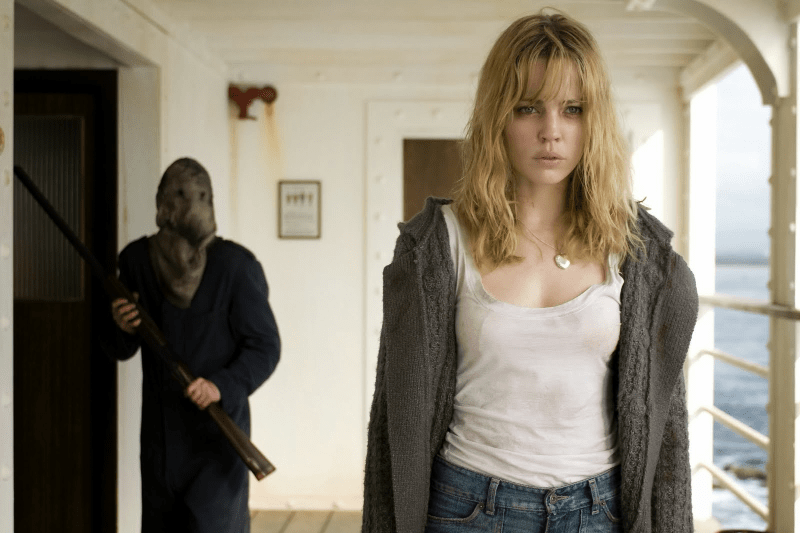It's 2022. So far, this column has explored Uterus Horror that tells the stories of werewolves, demons, aliens, and cannibals. This month, I’m here for the cult stuff. It’s time to discuss the 2019 indie gem, The Other Lamb.
Written by Catherine Smyth-McMullen (Nowhere Boys) and directed by Malgorzata Szumowska (Body), The Other Lamb follows young Selah (Raffey Cassidy). Selah lives in the remote wilderness with the polygamist cult she was born into. Shepherd (Michiel Huisman) is the leader of the cult and the only man in the compound. The other members consist of Shepherd’s wives and daughters, including Selah. Selah’s mother died during childbirth, so the other mothers/wives of the cult have cared for her into her teenage years. Whether because she is the motherless child of the group, or because of her budding maturity, Selah soon becomes the focus of Shepherd’s attention.
Visually, the women of the group are clearly divided. The wives (the mothers) wear red dresses while the sisters (the daughters) wear blue. Often in religious depictions, blue is a heavenly color of innocence and purity while red is sinful and relates to Hell. This is clearly a purposeful choice by Shepherd. The young girls—who haven’t gone through puberty yet—are innocent in his eyes. Conversely, the wives have bled, had sex, and given birth. While they are doing exactly what he wants them to do, the wives are the sinners and not Shepherd. He is also shown wearing either blue or gray to convey his lack of sin in his own eyes.
One night, a cop shows up at their compound and tells Shepherd he and his flock must leave. Selah is the only one to overhear this conversation. The next day, Shepherd announces he will be taking the women on a journey to find a new home. This journey is just the start of Selah discovering things about herself and the man she has followed so blindly her entire life.
Selah is on the razor's edge between being a girl and becoming a woman. Her entire life she has been protected by the adults around her, but we watch as that starts to shift. The women who have raised her soon become resentful and suspicious of the girl, especially because Shepherd pays her so much attention. They know the real reason behind his interest in the young girl.
At first, Selah revels in Shepherd’s affection. It makes her feel special; the man who leads them wants to spend more time with her than the other wives and sisters of the group. Yet, the more she learns about herself and this man, the more Selah realizes it’s all a farce. She becomes suspicious after spending time with Sarah (Denise Gough), one of Shepherd’s wives. Sarah is separated from the group as punishment for committing a “sin,” although we never truly learn what that sin is. Sarah tells Selah that her mother didn’t die during childbirth. Instead, she died from an infection shortly after, and Shepherd was the one who refused to take her to a hospital where she could have been saved.
When Selah gets her first period, she is forced to remain with Sarah in isolation because she is seen as “unclean” during her menstruation. There is meant to be a clear correlation within the cult between menstruation and sin. To Shepherd, these things are both punishable offenses.
A moment that is pivotal for the group is when one of the wives goes into early labor due to their strenuous travel in the wilderness. The wife dies in childbirth, and Shepherd tells the women that the child has to be left behind because it was “born wrong.” Sarah takes the baby and leaves the cult, but not before revealing to Selah that the baby is perfectly healthy. Shepherd simply wanted to leave it to die because the baby was born male and “there can only be one ram in a flock.”
The women are close to losing their faith in the man they follow, until they finally arrive at a beautiful piece of land by a lake. Shepherd declares this their new Eden and proceeds to baptize all the women in the lake. That night, Selah is called to Shepherd’s tent. She is a woman now, no longer protected by her childhood, so he rapes her.
When the sisters awake the next morning, they find Shepherd by the lake, the wives’ dresses at his feet. Shepherd claims the wives ascended, and now it is the sisters’ duty to become wives. It is clear to all the girls what the truth is, but Selah is the one to speak out against Shepherd. He slaps her, and she hits him right back. Some time later, the police discover the naked bodies of the drowned wives on the lake shore. Nearby is Shepherd’s body, strung up between two trees with ram horns attached to his head. Selah now leads the sisters away to their own Eden.
The Other Lamb offers a uniquely focused look at a single girl, in a closed-off community, experiencing Uterus Horror firsthand. It would be easy to view the acts depicted in this film as pure fiction or an exaggeration of real-life polygamist cults. Yet in many religions, including the more common ones, women are treated the same as this cult. The men are in control, they are looked upon as good and pure no matter what atrocities they carry out simply for being born male. The women, on the other hand, are only “pure” until the moment they reach puberty. From then on, the sins of men are forced upon the women. Shepherd may seem like a villain that could only exist in film, but men like him can be found in virtually every religion, society, and culture.
Despite the horrors witnessed in The Other Lamb, it is also a story of Selah’s growth and empowerment. When we first meet her, Selah is entitled, naïve, perhaps even unlikeable. She subconsciously understands she is at a phase in her life where she is innocent until proven guilty, which allows her certain freedoms. As she gains knowledge and develops into a young woman, we are introduced to a new Selah. She finally understands the role she is expected to play in her small community, and it’s a role she has no intention of taking. When she finally stands up to Shepherd, it’s not just for herself. It’s for her mother, Sarah; the dead wife; the baby boy; the other wives; her sisters. It’s the kind of empowerment we love to see in a Uterus Horror film, making way for Selah and her sisters to create their own matriarchal society. With Selah’s help, these young women have taken back the control Shepherd kept from them.
Smyth-McMullen and Szumowska wisely package this Uterus Horror tale in a polygamist cult wrapping, making the themes more palatable for the masses. That being said, these themes could be placed in virtually any patriarchal society or religion with similar results. The Other Lamb speaks to a larger issue of the roles women are forced into when they live within patriarchal societies and religions. Selah’s journey might be fictional, but it’s a journey many can relate to. If audiences can watch Selah empower herself to overcome the bonds that held her back from her true potential, perhaps it will inspire them to do the same.
About this series: in a genre typically considered “for the guys,” it’s time to give a nod to the ladies. Uterus Horror is a subgenre of horror films that focuses on the uniquely female experience of puberty and the act of coming into your sexuality, using horror elements to emphasize and/or act as a metaphor for that experience. These films are often ignored in theaters but quickly develop cult followings. Columnist Molly Henery, who named and defined the subgenre, tackles a new film each month and analyzes how it fits into this bloody new corner of horror.







